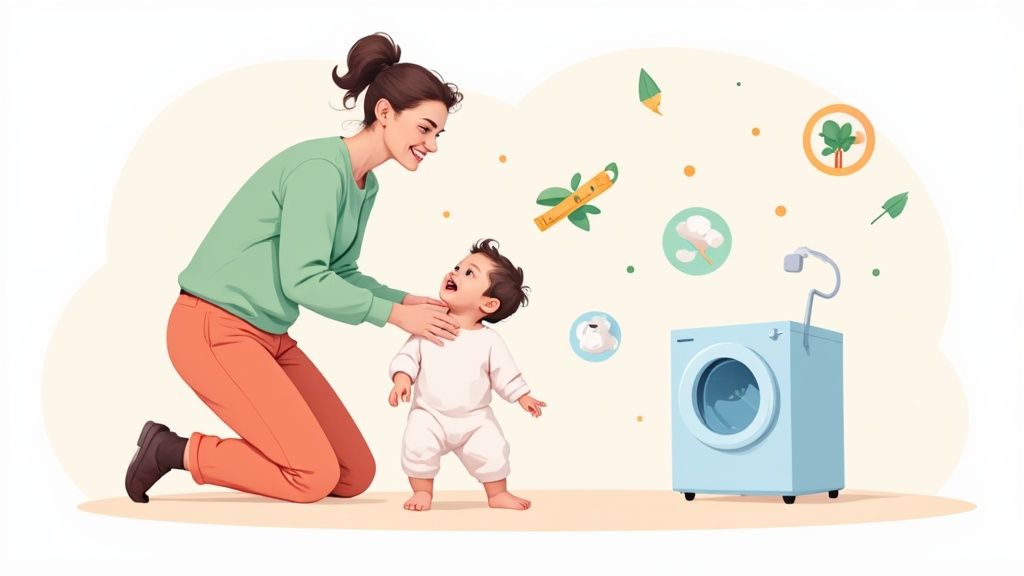
A Parent's Guide to Pajamas for Toddlers
Share
Picking out the right pajamas for your toddler isn't just about cute patterns—it's about finding that sweet spot between comfort, safety, and practicality that leads to a peaceful night for everyone. The best PJs are usually made from soft, breathable fabrics like bamboo or cotton, fit snugly to meet safety standards, and are designed for whatever stage your little one is in, from crawling to potty training.
Your Guide to Cozy and Safe Toddler Pajamas
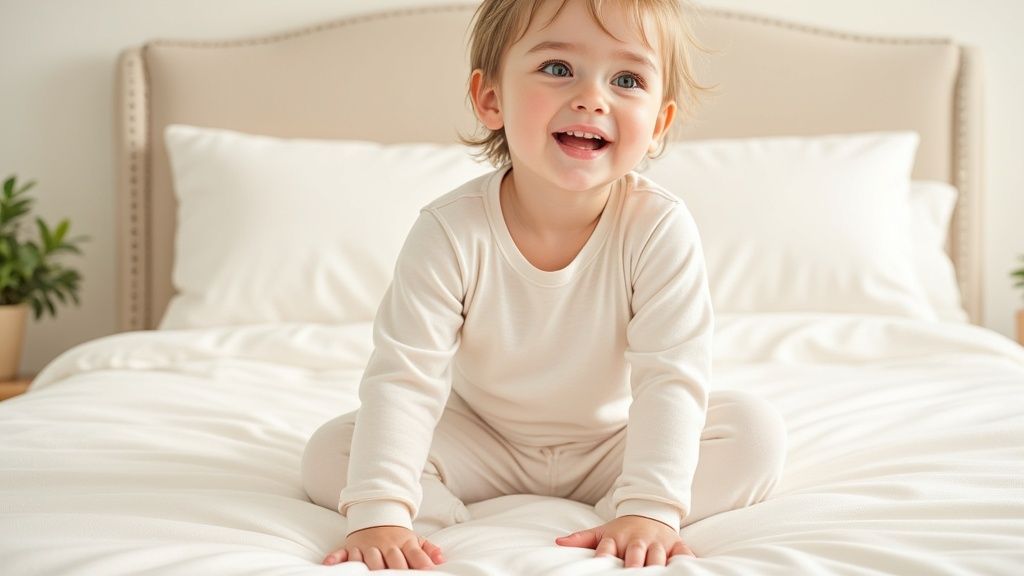
Welcome to the world of toddler PJs! If you feel like finding the perfect pair is a surprisingly big deal, you're right. The right pajamas are so much more than a tiny outfit; they're a key part of a good night's sleep, protecting your toddler's sensitive skin and giving you priceless peace of mind.
Think of this guide as your go-to resource for sorting through all the options out there, from buttery-soft bamboo sets to warm, fuzzy fleece. We're going to break down everything you need to know in a simple, practical way.
What We'll Cover
Here's a quick look at what we'll walk through together, helping you find pajamas for toddlers that they'll love wearing and you can feel great about.
- Fabric Fundamentals: We'll dive into why the material against your child's skin matters so much for their comfort and ability to regulate body temperature all night.
- Safety Demystified: I'll translate the safety standards and labels into plain English so you know exactly what to look for. No guesswork needed.
- Sizing Success: Get the scoop on how to nail toddler sizing for that perfect fit, so you can skip the hassle of returns.
- Style and Practicality: We’ll check out the different pajama styles that make bedtime routines, late-night diaper changes, and potty training a whole lot smoother.
Choosing the right sleepwear is one of those first big steps in creating a comforting and secure bedtime routine. It’s all about wrapping your child in something that feels good, keeps them safe, and gets them ready for a night of deep, restorative sleep.
My goal here is to give you the confidence to pick out PJs that are not only adorable but also genuinely functional and safe. We'll kick things off by looking at the most important element of all: the fabric. Let's get started on the path to cozier nights for your whole family.
Choosing the Best Fabric for Your Toddler's Skin
When you think about it, the pajamas your toddler wears are in contact with their skin all night long. That’s a lot of hours! So, the material really, really matters for a comfy, deep sleep. I know, standing in the store and reading all those tiny labels can feel like a pop quiz. But once you know what to look for, picking the perfect pair becomes second nature.
Think of it like dressing them for the weather, but for sleep. Some fabrics are like a light, breezy sundress, perfect for those sticky summer nights. Others are like a big, cozy sweater, just what you need when Jack Frost is nipping at the nose. Your job is to match the fabric to your child and the temperature of their room.
And it’s clear other parents are thinking the same way. The toddler wear market has exploded, valued at around USD 265.71 billion, and it's still growing. More and more, parents are hunting for better, safer materials like organic fabrics that are gentle on delicate skin.
The Most Popular Pajama Fabrics
Let's get into the nitty-gritty of the fabrics you’ll see most often. Each one has its own personality, with unique pros and cons that make it a great fit for some kids and not so much for others.
-
Classic Cotton: Good old cotton. It's a go-to for a reason—it's soft, tough enough to handle endless trips through the laundry, and easy on the wallet. It's the dependable workhorse of the pajama world. The only catch? It's not the best at breathing and can hold onto sweat, which can feel a bit damp and chilly on warmer nights.
-
Organic Cotton: This is cotton's superstar cousin. Grown without all the harsh synthetic pesticides and chemicals, organic cotton is a dream for toddlers with sensitive skin or allergies. You get all the durability of regular cotton, but it’s noticeably softer and a much kinder choice for the planet.
-
Bamboo Viscose: If you've ever touched bamboo PJs, you know. They have this incredibly buttery, almost silky feel that's just irresistible. Bamboo is also a triple threat: it's super breathable, wicks moisture away from the skin, and helps regulate body temperature. That means it keeps your little one cool when it's hot and cozy when it's not, making it a fantastic choice for any season.
-
Fleece and Flannel: When the thermostat plummets, these are the fabrics you reach for. Whether they're synthetic or cotton-based, fleece and flannel are designed to trap heat and keep your kiddo toasty warm. They’re perfect for drafty old houses or frigid winter nights. Just be careful—they don't breathe well, so they can easily lead to overheating if the room isn't cold enough.
Choosing the right material becomes even more important if your toddler has eczema or skin that gets irritated easily. Natural, breathable fibers like bamboo and organic cotton can be a total game-changer, helping to prevent flare-ups and keeping them comfortable all night. For a deeper dive, check out our guide on the best fabric for sensitive skin.
Toddler Pajama Fabric Comparison
To help you see it all at a glance, here’s a quick comparison table. It’s a handy cheat sheet for your next pajama shopping trip!
| Fabric Type | Best For | Pros | Cons |
|---|---|---|---|
| Bamboo Viscose | All seasons, sensitive skin, and temperature regulation | Exceptionally soft, breathable, moisture-wicking, hypoallergenic | Can be more expensive, requires gentle care |
| Organic Cotton | Sensitive skin, eco-conscious families | Very soft, breathable, durable, chemical-free | Higher price than regular cotton |
| Standard Cotton | Everyday wear, durability | Affordable, easy to find, holds up well in the wash | Less breathable, can trap moisture |
| Fleece/Flannel | Cold winter nights and chilly climates | Extremely warm, cozy, and soft | Not breathable, can cause overheating, often synthetic |
This table should make it a lot easier to weigh your options and find the perfect match for your little one's needs.
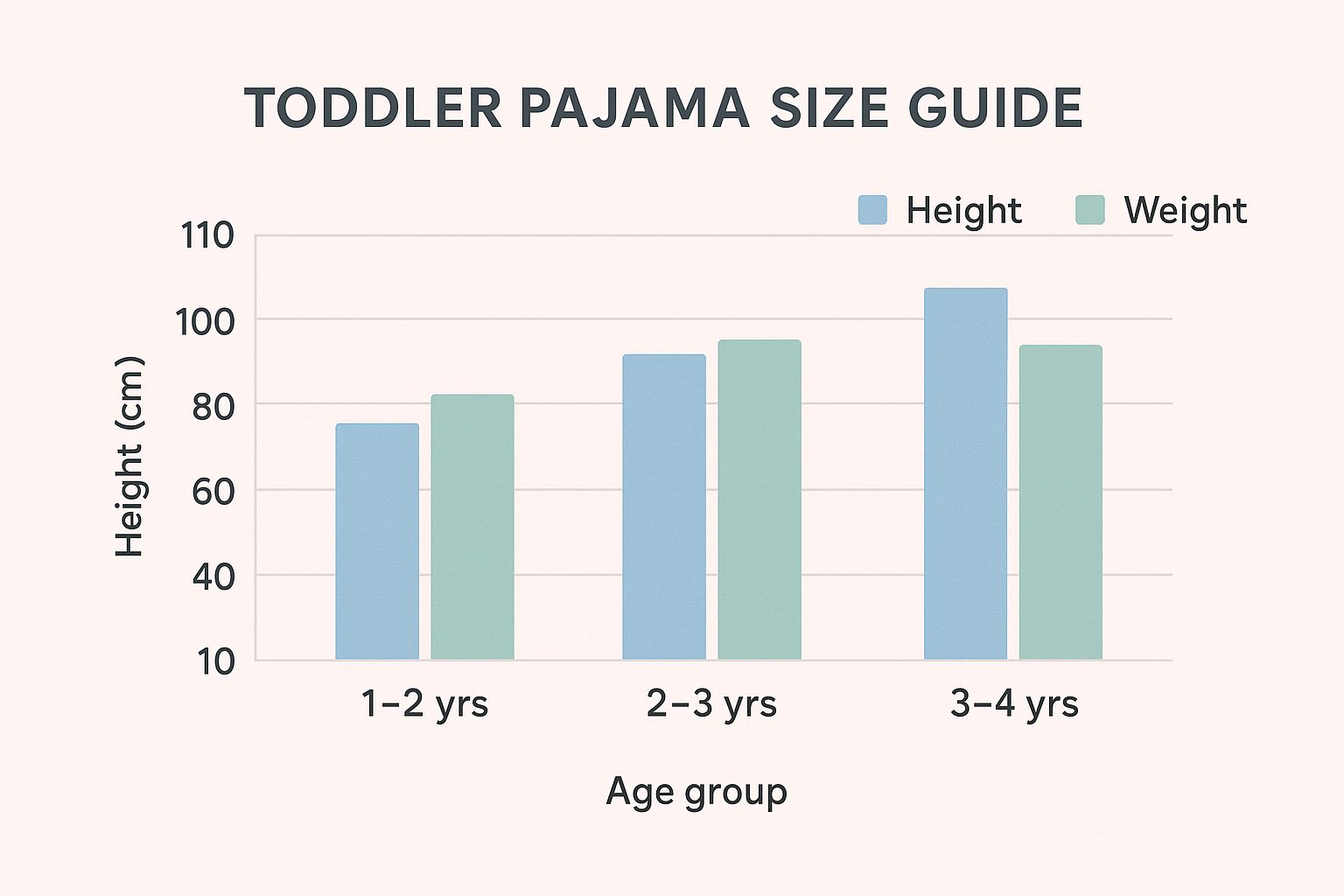
This chart is a great reminder of just how fast toddlers sprout up! It really drives home why it’s so much better to shop using their current height and weight instead of just grabbing a "2T" or "3T" off the rack. Now that you're a fabric expert, you’re all set to find those perfect PJs that will lead to a night of sweet, comfy dreams.
Decoding Toddler Pajama Safety Standards
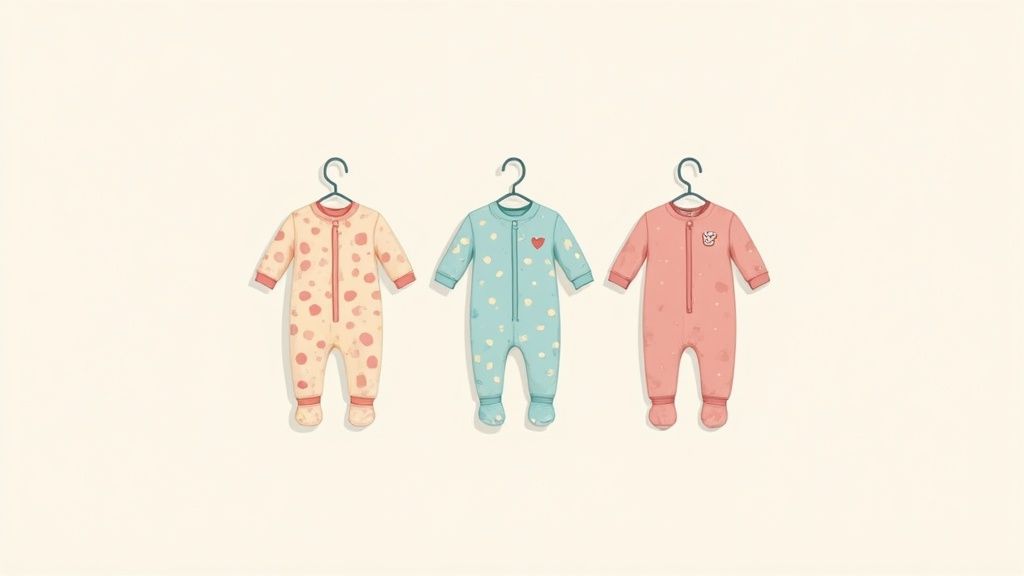
Let’s be honest, trying to understand all the labels and rules for toddler gear can feel like cramming for an exam you didn't know you had. But when it comes to pajamas, safety is non-negotiable, and thankfully, the rules are pretty simple once you know what to look for.
The U.S. Consumer Product Safety Commission (CPSC) has specific sleepwear rules in place to protect little ones (older than nine months) from burn risks. Basically, pajamas have to meet one of two conditions: they’re either flame-resistant or they’re snug-fitting.
Why the strict rule? Loose, billowy clothing can easily brush against a heat source—like a space heater, a candle, or a stove burner—and catch fire. Understanding your two main options here is the key to picking the safest PJs for your kiddo.
The Great Debate: Snug-Fit vs. Flame-Resistant
I always think of the "snug-fit" option as the common-sense choice. These are the pajamas you see that fit closely to your child's body, almost like a cozy second skin.
The thinking here is straightforward: with almost no air between the fabric and your toddler’s skin, there's less oxygen to feed a potential flame, making the material much less likely to ignite. This is why you’ll almost always find a big yellow tag on PJs made from natural fabrics like cotton or bamboo that says, "For child's safety, garment should fit snugly. This garment is not flame resistant." It’s a friendly, unmissable reminder.
Then you have flame-resistant pajamas. These are usually made from synthetic fabrics like polyester that are either inherently resistant to flames or have been treated with chemicals to make them so. They get the job done, but many parents (myself included) feel a little hesitant about putting chemically treated fabrics against a toddler's sensitive skin night after night.
One of the best ways to get peace of mind about the fabrics you're buying is to look for independent certifications. You can learn more about what the OEKO-TEX STANDARD 100 certification means and why it helps parents feel confident that what they're buying is free from a long list of harmful substances.
For many families, grabbing a pair of snug-fitting jammies made from a soft, untreated material like bamboo is the perfect sweet spot between proven safety and natural comfort.
Quick Safety Checks Every Parent Should Do
Beyond the fabric and fit, it's a great habit to give any pair of pajamas a quick once-over before you buy them, and even after you wash them. It only takes a second, but these little details are a huge deal for your toddler's safety.
Here’s a quick mental checklist to run through:
- No Drawstrings, Ever: Pajama hoods and waistbands should never have drawstrings. They are a serious strangulation hazard and are banned by the CPSC for a reason.
- Secure the Bling: Gently tug on any buttons, snaps, appliqué, or bows. If it feels loose, it could come off in the crib and become a choking hazard for a curious toddler.
- Check the Seams & Zippers: Run your hand along the inside of the pajamas. Are the seams smooth, or are they scratchy and likely to irritate your child’s skin? If it’s a zippered one-piece, make sure there’s a little fabric garage at the top to stop the zipper from pinching that delicate chin.
Bringing It All Together
At the end of the day, picking the safest PJs is all about being an informed parent. First, decide whether you're more comfortable with snug-fitting natural fabrics or flame-resistant synthetics.
After that, just give them a quick physical inspection for any potential red flags. When you combine these simple steps, you can rest easy knowing you've chosen pajamas that are not just adorable, but designed from top to bottom to keep your little one safe. And that peace of mind is what a good night's sleep is all about—for both of you.
A Parent's Guide to Toddler Pajama Sizing
We’ve all been there. You find the absolute cutest pair of PJs online, wait for the package to arrive, and then… they’re comically long in the legs or way too tight around the tummy. Trying to buy toddler pajamas can feel like a total guessing game, but it doesn't have to be.
The biggest secret? Ignore the age on the tag. A "2T" or "3T" is just a suggestion, not a hard-and-fast rule. Toddlers, just like us, come in all different shapes and sizes. One two-year-old might be tall and lanky, while another is shorter and more solid. They're rarely the "average" that those tags are based on.
That’s why the real key to a perfect fit is knowing your child's height and weight. These two little numbers give you a far more accurate picture of how clothes will actually fit their unique body, saving you the hassle of endless returns.
How to Measure for the Perfect Fit
Before you even start shopping, grab a measuring tape. It's a quick, two-step process that will make your life a whole lot easier. If you've got a wiggler on your hands, turn it into a fun game!
- Measure Their Height: Have your little one stand with their back against a wall, feet flat on the floor. Gently place a flat object, like a hardcover book, on their head and make a small mark where it meets the wall. Then, just measure from the floor up to your mark.
- Check Their Weight: The simplest way to do this is to hop on the scale yourself first. Then, pick up your toddler and weigh yourselves together. The difference between the two numbers is their weight.
Once you have these measurements, you're ready to tackle any size chart like a pro.
Remember, a good fit isn't just about being comfy—it's a critical part of pajama safety. Snug-fitting pajamas are designed that way for a reason. They minimize the air between the fabric and your child's skin, which dramatically reduces flammability risks. PJs that are too loose can be a serious hazard.
Decoding a Brand’s Size Chart
Here's the thing: every brand is different. A 3T from one store might fit completely differently than a 3T from another. This is why you should always find and check the specific brand's size chart before adding anything to your cart.
These charts are your best friend because they connect the sizes directly to the height and weight measurements you just took. To see exactly what we mean, you can explore our Little Venture Co. size chart and see how we match our cozy bamboo sleepwear to your child's measurements.
To give you an idea, here’s a look at what a typical brand’s sizing might be.
Standard Toddler Pajama Sizing Chart
This table is just an example, but it shows how most brands use height and weight to guide you to the right size.
| Size | Typical Height (inches) | Typical Weight (lbs) |
|---|---|---|
| 18-24M | 31" - 33" | 25 lbs - 28 lbs |
| 2T | 33" - 35" | 28 lbs - 32 lbs |
| 3T | 35" - 38" | 32 lbs - 35 lbs |
| 4T | 38" - 41" | 35 lbs - 39 lbs |
Always refer back to the specific chart for the PJs you're looking to buy!
Troubleshooting Common Fit Problems
Even when you measure carefully, you can run into a few tricky spots. Here’s a quick guide to solving them:
- In Between Sizes? If your toddler’s measurements fall between two sizes, always size up. This gives them a little extra room to grow into and prepares you for any potential shrinking in the wash.
- Shrinkage is Real: Natural fibers like 100% cotton are known to shrink a bit, especially after their first trip through a hot wash and dry cycle. Sizing up gives you a necessary buffer.
- The Final Fit Check: Once the new PJs are on, they should look snug but never feel restrictive. You should be able to slide a finger easily between the fabric and your toddler's skin at the wrists, ankles, and waist. Most importantly, they should be able to run, jump, and wiggle freely without the fabric pulling.
By swapping the age tag for actual measurements, you’ll nail the perfect, comfy, and safe pajamas for your toddler every time.
Picking the Right Pajama Style for Your Toddler
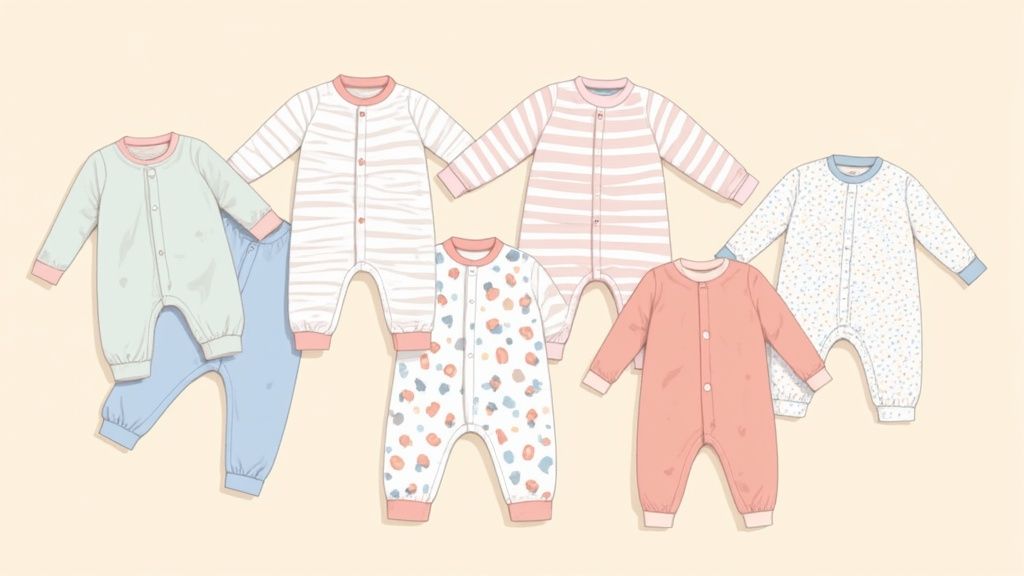
So you've figured out the best fabric and found the right size. Awesome! The next piece of the puzzle is picking a style. This might seem like it’s all about cute patterns, but the design of your toddler's PJs can honestly make your life a whole lot easier, smoothing out everything from midnight diaper changes to those hectic morning routines.
Choosing a style is really a practical decision. It’s about matching the pajamas to where your toddler is right now. A one-year-old who’s still wobbly on their feet has totally different needs than a three-year-old who’s knee-deep in potty training. Let's walk through the most common styles so you can see which one makes the most sense for your family.
This blend of comfort and real-world practicality is why the kids' sleepwear market has exploded. It was recently valued at around USD 4.55 billion globally and is only expected to keep growing. It just goes to show how much parents are looking for sleepwear that’s not just cute, but also smart and functional for their little ones.
The Classic Debate: One-Piece vs. Two-Piece Pajamas
When you're shopping for pajamas for toddlers, you'll mostly see two main players: the classic one-piece sleeper and the ever-versatile two-piece set. Each has its own perks, and the best choice really depends on your child's age and what they're up to.
Think of the one-piece sleeper as a big, cozy hug in clothing form. It’s a single garment that usually zips or snaps all the way from their neck to their ankle, making sure your toddler stays completely covered and warm all night. No gaps for chilly drafts to sneak in! That's a huge win for younger toddlers who tend to kick off their blankets.
A one-piece sleeper is fantastic for keeping your little one bundled up and secure. But once potty training begins, fumbling with a full-body zipper in the middle of the night can be a real challenge for both of you.
On the flip side, two-piece sets are the champions of independence. A separate top and bottom make potty training so much simpler. Your toddler can just pull their pants down without needing you to help them out of an entire outfit. It seems like a small thing, but it’s a massive confidence booster for them and a total sanity-saver for you.
Footed vs. Footless: A Matter of Balance
Digging a little deeper into the one-piece world, you’ll find two variations: footed and footless. The right choice here often boils down to how mobile your little one is.
Footed pajamas are amazing for keeping tiny toes warm without socks—which, let's be real, are going to get kicked off anyway. They’re perfect for babies and crawlers. But once your toddler starts walking, those built-in fabric feet can be a little slippery on hardwood or tile floors, making it harder for them to feel the ground and keep their balance.
This is where footless pajamas really shine. You get all the warmth and coverage of a one-piece, but their feet are free to grip the floor. This is much safer for active toddlers who are busy mastering walking, running, and climbing all over your furniture.
Matching Styles to the Seasons
Finally, just like you swap out your own clothes when the weather changes, your toddler's PJs should adapt to the seasons to keep them comfy.
- For Warm Summer Nights: Go for lightweight and breathable two-piece sets. A short-sleeved top with shorts, especially in a material like bamboo viscose, allows for plenty of airflow to keep them from getting hot and sticky.
- For Cold Winter Nights: Cozy fleece or flannel one-pieces are your best friend. These thicker materials are great at trapping body heat, creating a snuggly little cocoon for your child, even if the temperature dips overnight.
By thinking about your child's stage, what's most convenient for you, and the time of year, you can pick a pajama style that makes bedtime a breeze for everyone. For some incredibly soft and practical options, check out our collection of two-piece pajama sets.
How to Care for Your Toddler's Pajamas
So you’ve found the perfect set of pajamas! Now, how do you keep them looking and feeling brand new? Proper care is about more than just keeping them clean—it’s about preserving that cozy softness and making sure the safety features stay intact, wash after wash.
Don't worry, it's not complicated. A few simple habits can make a world of difference in extending the life of your toddler’s favorite PJs.
Gentle Washing for Lasting Softness
Let's start with the wash. The first rule of toddler laundry is to pick the right detergent. Go for something gentle, hypoallergenic, and dye-free to protect your little one's sensitive skin. Harsh chemicals can leave behind residue that causes itchiness and ruins a good night's sleep.
When you're ready to load the machine, cold water is your best friend.
- Stick to a Cold, Gentle Cycle: This is the secret to preventing common fabrics like cotton and bamboo from shrinking. It also keeps those adorable prints and bright colors from fading.
- Zip Up and Snap Shut: Before you toss everything in, take a second to zip up any zippers and snap all the snaps. This tiny step prevents them from snagging on other clothes and causing rips or tears.
- Tumble Dry on Low: High heat is the number one enemy of soft pajamas. It causes shrinking and breaks down those delicate fibers over time. If you use a dryer, always use the lowest heat setting. For super-soft materials like bamboo, letting them air dry is an even better call.
Here's a critical safety tip: Never use fabric softener or dryer sheets on any pajamas labeled as "flame-resistant." These products leave a coating on the fabric that can completely negate its flame-resistant qualities, which is a serious safety risk.
Tackling Tough Toddler Stains
Toddlers and messes go hand in hand. Spilled milk, a rogue crayon, a bit of breakfast—it’s all part of the fun. The key to stain removal is acting fast.
For most everyday spills, a little pre-treatment is all you need.
- Rinse It Right Away: The moment a spill happens, rinse the spot with cold water. Make sure to rinse from the back of the fabric to push the stain out instead of setting it in deeper.
- Apply a Gentle Stain Fighter: Dab a small amount of your baby-safe detergent or a gentle stain remover directly onto the spot.
- Give It Time: Let the treatment sit for at least 15-20 minutes before washing as usual. For really stubborn stains, you might need to gently rub the fabric together to work it in.
Following these simple steps will keep those PJs safe, soft, and ready for countless cozy nights and sweet dreams. A little extra care goes a long way
Got Questions About Toddler Pajamas? We’ve Got Answers.
When you're a parent, even something as simple as buying pajamas can feel like a big decision. Sizing, safety, how many pairs to buy… it’s a lot to think about! Let's clear up some of the most common questions we get, so you can feel totally confident picking out the perfect PJs for your little one.
Choosing the right sleepwear is a big deal for parents everywhere. In North America alone, the kids' pajama market is valued at a whopping USD 6.2 billion. That’s because parents are more focused than ever on health and safety, which pushes brands to meet really strict fire safety rules. If you're curious, you can dive deeper into the global demand for safe toddler PJs and see how things look around the world.
How Many Pairs of Pajamas Does a Toddler Actually Need?
Ah, the million-dollar question! While there isn't one perfect number, a great place to start is with 5 to 7 pairs of pajamas.
Having this many on hand means you won't be scrambling on laundry day. It also gives you a backup for those surprise middle-of-the-night leaky diapers or spit-up situations. Trust me, having a clean pair ready to go at 2 AM makes life so much easier.
- For Everyday Life: A rotation of five pairs usually works perfectly for a normal week.
- For Potty Training: You might want to bump that number up to seven or eight. More accidents mean more laundry!
At the end of the day, having a few extra pairs is all about peace of mind. You’ll know your toddler always has a clean, dry, and cozy set of PJs waiting for them, no matter what surprises the day (or night) throws at you.
Should Toddlers Wear Socks with Their Pajamas?
This one really comes down to how warm your child's room is and what kind of PJs they're wearing. If your toddler is in footed pajamas, you can skip the socks. Those little built-in feet are designed to keep their toes perfectly toasty, and adding socks could actually make them overheat.
On the other hand, if they're wearing footless PJs on a chilly night, socks are a great idea for that extra bit of warmth. Just make sure the socks aren't too tight—you want to keep their circulation flowing freely while they sleep.
Why Do Toddler Pajamas Have to Be So Snug?
This is probably one of the most important things to understand about toddler sleepwear. That tight fit isn’t just a style choice; it’s a critical safety feature required by the U.S. Consumer Product Safety Commission (CPSC). This rule applies specifically to pajamas made from fabrics that aren't flame-resistant, like cotton and bamboo.
The logic is simple but so important: loose-fitting clothes can catch fire more easily if they come near a heat source. A snug fit means there’s less air between the fabric and your child’s skin, which dramatically slows down the risk of the garment catching fire and spreading flames.
So next time you see that yellow tag that reads, "For child's safety, garment should fit snugly," you’ll know it’s there to protect them. Always look for PJs that hug their body comfortably without being too tight, ensuring they’re both safe and sound all night long.
At Little Venture Co., we design our buttery-soft bamboo pajamas to be perfectly snug, comfortable, and safe for your little one's delicate skin. Explore our faith-inspired collections and wrap your child in comfort that makes a difference. https://littleventureco.com
